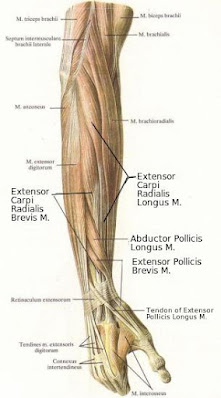The muscles involved in forearm supination and rotation are five in number. They cause the dextrous rotation of forearm and wrist and a twisting fashion. Human beings have been exerting fine and controlled rotatory movements of their forearm and wrist for hundreds of thousands of years, from twisting a spear shaft to sharpen its point, or an animal bone, in order to break off the tendons to dislodge it out of its carcass, to wield a rapier in parrying and thrusting or to turn a screwdriver or a socket wrench.
These five muscles that make possible this voluntary and nimble rotation of the human forearm and hand are the supinator, pronator quadratus, the pronator teres, the anconeus, and the biceps brachii muscle. They are located deep in the forearm and, superficially, in the arm. The use of these muscles, along with other muscles of the hand, have been closely related to the evolution of the cerebral cortex.
The supinator is a broad short muscle, with two heads, which arise from the humerus lateral epicondyle and the posterior surface of the ulna proximal end. Then it wraps around the head and neck and posterior surface of the radius to attach on the lateral surface of this bone. Function: it supinates (turns over) the forearm and hand, with the palm looking upwards. The supinator is supplied by the posterior interosseous nerve, which is deep branch of the radial nerve.
The pronator quadratus is a flat, short, and square muscle which stretches across the distal (lower) end of the radius and ulna bone. With strong aponeurosis (fibrous connective tissue), it originates from the oblique, linear ridge located on the anterior (front) surface of the ulna shaft, and crosses over the interosseous space to attach on the distal anterior surface of the radius bone. The pronator quadratus function is the pronation (rotation) of the hand. It is innervated by the anterior interosseous branch of the median nerve, and is supplied by small, side branches coming off the ulnar, radial, and anterior interosseous arteries.
The pronator teres is a flat and long muscle of the forearm, arising from the medial epicondyle (rounded bone projection) and supraepicondyle ridge of the humerus bone. Then it runs downwards and obliquely, crossing over the ulna, to attach on a rough area in the middle lateral surface of the radius. Function: it turns the radius over the ulna during pronation. It is innervated by the median nerve. It is supplied by branches from the radial, common interosseous, and ulnar artery.
The anconeus is flat and triangular in shape, arising from the lateral epicondyle of the humerus. It inserts in the posterolateral surface of the ulna. Function: it slightly abducts (separates) the ulna from the radius during pronation. The anconeus muscle is innervated by a branch of the radial nerve, and is supplied by branches from the recurrent radial and inferior ulnar collateral artery.
The biceps brachii is the largest and most powerful of the five upper limb muscles that rotate (pronate and supinate) the forearm and hand. The biceps is a supinator of the forearm. It is innervated by the musculocutaneous nerve (C5, C6), which originated from the brachial plexus.
Below, the main muscles involved in supination and pronation of the forearm and hand: supinator, pronator teres, and pronator quadratus.













